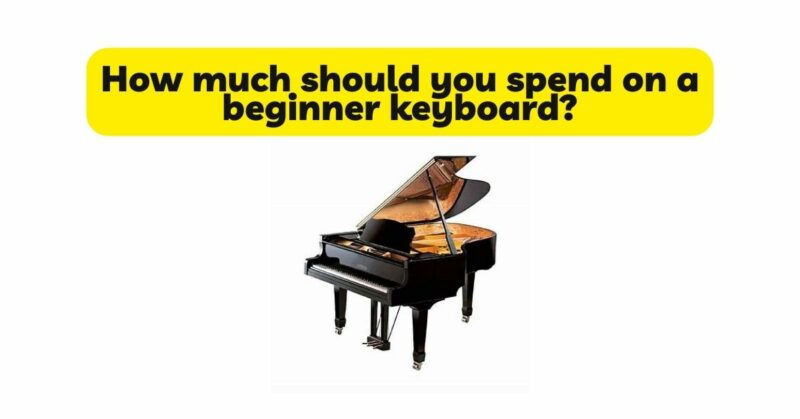When beginning your musical journey on the keyboard, determining how much to spend on a beginner keyboard is a crucial decision. The cost of a beginner keyboard can vary significantly depending on factors such as the type of keyboard, brand reputation, features, build quality, and personal preferences. This article aims to provide guidance on setting a budget for a beginner keyboard, considering factors such as affordability, quality, features, and long-term musical aspirations. By striking the right balance between your budget and the essential elements of a beginner keyboard, you can embark on your musical journey with confidence.
Understanding Affordability and Value for Money:
- Affordability: Affordability is a key consideration when determining your budget for a beginner keyboard. It’s important to assess your financial resources and set a budget that you’re comfortable with. As a beginner, it’s not necessary to invest in the most expensive keyboard available. Many affordable options offer satisfactory playing experiences and functionality for beginners.
- Value for Money: While affordability is important, it’s equally crucial to consider the value for money offered by a beginner keyboard. Value for money refers to the balance between the cost of the keyboard and the features, quality, and longevity it provides. A keyboard that offers a satisfactory playing experience, durability, and essential features at an affordable price can be considered a good value for money.
Factors to Consider:
- Keyboard Type:
a. Digital Keyboards: Digital keyboards are popular choices for beginners due to their affordability, versatility, and ease of use. Entry-level digital keyboards can range from around $100 to $300, offering basic functionality, different instrument sounds, and built-in learning tools. These keyboards provide a satisfactory playing experience for beginners and are a cost-effective option.
b. Workstations and Synthesizers: Workstations and synthesizers are more advanced digital keyboards that offer additional features, sound manipulation capabilities, and recording options. These keyboards can range from $300 to $1,000 or more, depending on the brand, features, and specifications. While they may offer more advanced functionalities, they may not be necessary for beginners unless they have specific musical interests or goals.
c. Acoustic Pianos: Acoustic pianos, including upright pianos and grand pianos, are the traditional choice for keyboardists. However, they tend to be more expensive and require regular maintenance. For beginners on a budget, acoustic pianos may not be the most practical choice unless there is a strong preference for the authentic playing experience they offer.
- Brand Reputation:
Brand reputation can play a role in the pricing of beginner keyboards. Established brands such as Yamaha, Casio, Roland, and Korg have a history of producing reliable instruments across various price points. These brands often offer entry-level keyboards that provide a good balance of affordability and quality. However, lesser-known brands can also provide excellent options, so it’s worth considering their offerings as well. Researching user reviews and seeking recommendations from experienced musicians can help identify reliable brands within your budget.
- Quality and Durability:
While affordability is important, it’s essential to consider the quality and durability of a beginner keyboard. A keyboard with good build quality will withstand regular practice and usage, providing a more satisfactory playing experience. Entry-level keyboards may not have the same longevity as higher-end models, but selecting one with a solid construction and reliable components ensures it will serve you well as you progress on your musical journey.
- Essential Features:
Consider the essential features required for a beginner keyboard. These may include different instrument sounds, touch sensitivity, weighted or semi-weighted keys, headphone connectivity, built-in speakers, and basic recording capabilities. As a beginner, you may not need all the advanced features found in higher-end keyboards, so prioritize the features that are essential for your learning and playing experience.
- Long-Term Aspirations:
Consider your long-term aspirations as a keyboardist. If you have serious intentions to progress and continue playing beyond the beginner level, you may want to invest in a slightly higher-quality keyboard that can accommodate your growing skills. While it may require a slightly higher budget, a more advanced instrument will provide a more satisfying playing experience and support your musical development as you progress.
- Accessories and Additional Costs:
Factor in any additional costs associated with the keyboard. Consider accessories such as a keyboard stand, sustain pedal, bench, headphones, and a carrying case. These items may not be included with the keyboard and may need to be purchased separately. Be sure to include these potential costs in your budget to ensure a complete and comfortable playing setup.
Conclusion:
Setting a budget for a beginner keyboard involves considering factors such as affordability, value for money, brand reputation, quality, essential features, and long-term aspirations. As a beginner, there are many affordable options available that provide a satisfactory playing experience and functionality. Assess your budget and prioritize the features that are essential to your learning and playing experience. Consider reputable brands known for producing reliable instruments, but also explore offerings from lesser-known brands. Remember that while a higher budget can provide access to more advanced keyboards, there are satisfactory options available at various price points. Ultimately, the most important aspect is to find a beginner keyboard that inspires you to practice, explore, and progress on your musical journey.


